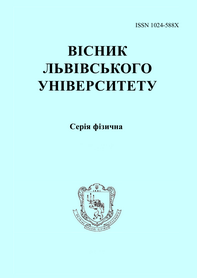DOI: https://doi.org/10.30970/vph.59.2022.15
Ionization-correction factors obtained by photoionization modeling of the low-metalicity H II regions surrounding continuous star formation.
I. Koshmak

| Visnyk of the Lviv University. Series Physics
59 (2022) с. 15-22
DOI: https://doi.org/10.30970/vph.59.2022.15 Ionization-correction factors obtained by photoionization modeling of the low-metalicity H II regions surrounding continuous star formation.I. Koshmak |  |
This work is a direct continuation of \cite{Visnyk-2021}, where multicomponent photoionization modeling of low-metalicity H II regions around areas of continuous star formation was obtained, in particular, synthetic fluxes of strong forbidden lines and ionic abundances of chemical elements. This multicomponent photoionization modeling takes into account complex structure of H II region formed by the effect of superwind from the center of star-forming region. The complex structure of H II regions can be divided into internal and external components. The internal components correspond to the region of free expansion of the superwind and the superwind cavity, respectively, and the external ones to the dense gas shell compressed by the direct shock wave of the superwind and the hydrodynamically undisturbed outer part of the H II region, where most of the observed strong emission lines are formed. The simulation components were calculated under the assumption of spherical symmetry. Photoinization of the gas was caused by ionizing quanta of both direct and diffuse ionizing radiation. The fluxes of this radiation were calculated during modeling using radiation transfer equations that take into account all the important processes in the H II region that cause this transfer. For the region of free expansion of the superwind, the input spectrum of ionizing radiation, the velocity of the superwind, and the chemical abundance were determined using models of evolutionary-population synthesis \cite{Starburst99} in the region of continuous star formation. During photoionization modeling, the distributions of electron temperature and density in the external components were obtained as a solution of the energy balance equation. The stopping criterion for evolutionary modeling was the condition of equality of pressure at the boundary between the third and fourth components. In this paper, we select the best models whose relative intensities best reproduce the corresponding observed relative intensities. The ionic abundances of chemical elements obtained in the selected models were used to obtain ionization-correction factors (ICF). With the help of ICF, it is possible to further determine the relative chemical abundances of elements and redetermine the abundance of primordial helium and the rate of its enrichment during stellar chemical evolution of matter, as was done for low-metalicity H II regions around starburst regions \cite{AASP2018}.